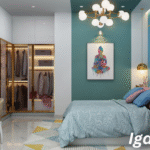Let me start by saying something you wouldn’t expect from someone who’s been designing websites since the MySpace era: Web design is getting weirder—and better—for it. And I love it.
I’m part of Above Bits, or AB for short. We’re the crew quietly crafting websites for businesses across North Carolina and beyond, building things that aren’t just pretty, but perform. Lately, though, what we make in Charlotte has been shaped by a global creative storm that includes… Icelandic brutalism, Instagram’s vanishing attention span, and a whole lot of indie developers pushing limits from their basements.
Web design in Charlotte is anything but local. It’s a melting pot of aesthetics, UX philosophies, and technological rebellions, stitched together with the practicality of the Southern market. And that fusion? It’s never been more exciting—or unpredictable.
The Reykjavík Revelation: How Iceland’s Design Scene Punched Through the Web
A few years ago, no one in Charlotte was talking about Brutalist design. But something funny happened around 2021. Websites from Scandinavian countries—especially Iceland—began appearing in CSS Design Awards and Awwwards lists, breaking every rule of symmetry and softness that defined early 2010s web design. Harsh typography, grayscale schemes, minimal navigation, and a complete disregard for “user comfort” suddenly became… cool.
Why? Because users were bored. They wanted something raw, honest, even jarring. Web design in Charlotte, thanks to global portfolios being shared on platforms like Dribbble, Behance, and even TikTok, has begun to incorporate some of those polarizing design trends.
At AB, we’re not turning every site into a Nordic art piece, but we do borrow from those principles. For example, one of our recent redesigns for a Charlotte-based nonprofit embraced asymmetry and massive, unapologetic headings. The bounce rate dropped. Engagement went up. Coincidence? Probably not.
Instagram Is Slowly Killing Menus—and That’s Not Always a Bad Thing
Let’s talk about something Charlotte businesses constantly ask us: “Where should the menu go on mobile?”
Ten years ago, the answer was straightforward: the top-right corner, with a hamburger icon, marked ‘done’. But Instagram, TikTok, and Snap have subtly rewired how people explore content. Swipe-first behavior, no top menus, infinite scroll—these patterns are reshaping how people expect websites to behave. People don’t want to “navigate” anymore. They want to flow.
We once tested a site for a Charlotte brewery where the home page was the navigation. Scroll, and everything appears in sequence—beer, events, merch, contact—no clicking required. To our surprise, users stayed longer and interacted with more content than on their old tab-based setup. That’s when I realized: web design in Charlotte is being directly influenced by apps, even if no one talks about it.
However, there’s a downside: if you go too “app-like,” users who still expect traditional UX, especially older users, become frustrated. At Above Bits, we walk that fine line. Charlotte has a diverse demographic, and design needs to meet them halfway, not just chase trends.
The Indie Dev Revolution and the Rise of the One-Person Website
Something else is happening globally, and it’s influencing small business websites more than enterprise CMSs ever did: indie developers are winning hearts with lean, fast, and brutally functional websites. No WordPress plugins. No preloader animations that last longer than your coffee.
These folks are building sites using static site generators like Hugo, 11ty, and Astro. They’re using minimal JavaScript and prioritizing Lighthouse scores as if it were a competitive sport. And users—especially the privacy-conscious crowd—are eating it up.
At AB, we’re no strangers to this lean design philosophy. Web design in Charlotte has significantly benefited from it. Small businesses, especially in sectors such as law, healthcare, and education, don’t need 37 plugins and a React front-end. They need clarity, SEO speed, and reliability—things that indie developers have made cool again.
Globally, the rise of JAMstack and serverless architecture means that more design is happening in tandem with code. At Above Bits, we’ve leaned into that hybrid. Designers talk to developers early. We don’t just “hand off.” The result? Faster load times and less finger-pointing when something breaks.
When the World Got Loud, Charlotte Got Clear
Design used to shout. Now, it whispers at least, when it’s good.
There’s a global trend toward clarity over flash, especially post-pandemic. After 2020, users developed “digital fatigue.” Animated everything, excessive popups, autoplay video—none of it felt charming anymore. They wanted clarity. Breathing room. And faster loading, no matter where they were.
A 2023 Statista study revealed that 45% of users abandon mobile sites that take more than 3 seconds to load. Google backed it up with data showing a correlation between page load times and bounce rates. And if that wasn’t enough, Amazon once reported that every extra 100ms of load time cost them 1% in sales. That’s Amazon. Imagine what it does to your average BBQ joint in Charlotte.
When we discuss web design in Charlotte, we’re not just talking about aesthetics. We’re talking about infrastructure. AB has been doing this for nearly two decades, so we’ve learned that you can’t separate design from devops, from hosting choices, from the backbone tech that keeps everything humming behind the scenes.
If a user doesn’t feel clarity in the first two seconds, they’re gone. Global truth, local consequence.
A Quick Pause to Appreciate the Weird
Here’s a delightful fact from Japan: there’s a government website about taxes that uses ASCII art cats as part of its user interface. And people love it. It’s weird. It’s playful. And it works.
That’s the beauty of modern web design. It’s allowed to be strange, even whimsical, as long as it delivers.
And that’s the approach we’re bringing to web design in Charlotte. Clients still want ROI, speed, and conversion—but they’re more open than ever to a bit of personality. The era of generic templates and stock-photo smiles is fading. Visitors can smell a fake from a mile away.
We’ve even worked on Charlotte projects where the client wanted hand-drawn illustrations, GIF buttons, or nostalgia-inspired navigation. Did it work? Yes. Did we love it? Absolutely.
Sometimes, the secret sauce in great design is a willingness to be a little odd, without losing clarity. We think that’s where Charlotte is heading: global flair, local heart.
The Pixels Strike Back — New Tools, Wild Ideas, and the Charlotte Edge
Let’s talk about tools.
It used to be that Adobe Photoshop was king. You’d lay out your entire site in. PSD files, email them to someone named Brad, and hope for the best. Now? Web design feels more like a playground of synchronized innovation. And if you’re doing web design in Charlotte, staying updated isn’t optional — it’s survival.
At Above Bits, we’ve danced through the evolution. We saw Figma rise from a quirky startup into the industry’s collaborative darling. We watched Webflow try to replace developers — and then watched developers integrate it anyway. We even experimented with generative design AI like Uizard and Framer AI. Some tools help us fly. Others just added lag.
Globally, Figma holds nearly 80% of market share among UI/UX designers (source: UX Tools 2024 survey), and for good reason. Real-time collaboration, component systems, and a thriving plugin ecosystem mean designers don’t just “hand off” anymore. They build together. At AB, we’ve had clients from Charlotte log into a Figma file during a meeting to adjust their homepage banner. It’s the kind of democratized design that was unheard of 10 years ago — and yet, it’s now part of our daily routine.
When “Clean” Becomes Sterile — The Downside of Trends
But let’s not drink the Kool-Aid without asking what’s in it.
One of the most common complaints we hear from business owners, both in Charlotte and beyond, is that modern websites all look the same. White background. Soft pastels. Rounded buttons. Subtle gradients. Helvetica or Inter. Sections are spaced exactly 100px apart. It’s as if every site graduated from the same Scandinavian design academy.
It’s efficient. It’s minimalist. And, let’s be honest, it’s a little boring.
This uniformity is partially the result of popular design systems, such as Material Design and Bootstrap. They offer consistency, sure — but also tend to suffocate originality. And originality matters, especially in places like Charlotte, where local flavor means more than a palette of blues and grays.
At Above Bits, we take that seriously. We’ve worked with clients who sought a blend of rustic Southern charm and modern design. Others wanted brutalism on the front-end and buttery performance under the hood. The trick isn’t to throw away trends — it’s to use them as seasoning, not the whole meal.
While web design in Charlotte may borrow global elements, we customize every pixel to match the business’s unique vibe. Your yoga studio shouldn’t look like a fintech app. Your local hardware supplier shouldn’t look like a DTC sock company from Berlin. You get the idea.
Loading Bars and Rage Clicks: Why UX Is the New Battleground
Let’s get a little nerdy for a second.
In 2025, user experience (UX) is the line between conversion and exit. A Microsoft study once showed that humans now have shorter attention spans than goldfish — we’re down to about 8.25 seconds. And that’s before your slow-loading background video chimes in.
That’s why Above Bits designs with performance-first UX in mind. Every tap, scroll, and click should feel like the site was built just for you. We track rage clicks, heat maps, scroll depths — not because we’re creepy (though those tools are spooky), but because that data shows us what frustrates users.
When it comes to web design in Charlotte, this isn’t just about design aesthetics. It’s about business outcomes. Slower sites lose customers—confusing navigation tanks sales. Bad mobile design kills engagement.
We once redesigned a Charlotte medical service’s website that had five—yes, five—contact forms hidden across different pages. People were either confused or giving up entirely. We reduced it to one floating button with a sticky footer. Conversions doubled. Double. Just from UX clarity.
A Quick Tour of Tools That (Might) Change Everything
Let’s shift gears and talk about what’s on the horizon. If you’re reading this as a business owner or a curious developer, here’s what’s shaking up the field.
One of the hottest names right now? Squoosh.app – a tiny but mighty image compressor developed by Google. It makes WebP conversion seamless and shaves megabytes off sites. Not flashy, but critical.
Then there’s Spline and Three.js, which enable designers to incorporate interactive 3D elements into web design without needing to go full Pixar. At Above Bits, we’ve used them to build immersive environments for product demos. Picture rotating a chair or changing a paint color right on the site — and watching customers stick around just to play.
Not to be left out, Framer has become the darling of the “design and deploy” crowd. Unlike Figma, Framer allows you to launch a working website directly from a design file. However, it comes with caveats — the SEO isn’t perfect, loading times need optimization, and many businesses still outgrow its limits once complexity arises.
When web design in Charlotte aims to balance affordability with performance, we often mix tools. We might use Framer for MVPs, Figma for design, then code custom components in Vue or Tailwind once things scale. The tools are only as powerful as the people using them — and after 19 years of hands-on experience, we’ve got some strong opinions on when to use which.
Trends That Make Sense (and One That Doesn’t)
Now, a few trends that actually make a positive impact:
Dark Mode Everywhere: Not just for your eyes. It reduces energy usage on OLED screens, and many users now have it as their default setting. We always design both light and dark variants, especially for night-owl audiences.
Micro-animations: When used sparingly, they provide valuable feedback and enhance user engagement. Think hover states, button transitions, and smooth scroll effects. But when they’re abused? Users feel like they’re trapped in a PowerPoint presentation.
Content-First Design: This one’s long overdue. Design no longer comes first — content does. You can’t build a meaningful layout without knowing what it needs to say. That’s why AB always asks for a copy early. Charlotte businesses with rich stories deserve more than lorem ipsum.
The one trend we’re officially banning? Excessive loading animations. Look, your spinning logo is cute the first time. However, if I see it three times before reaching your pricing page, we’re done here.
Charlotte at the Crossroads of Creativity
I’ve been saying it for a while now, but it’s worth repeating: web design in Charlotte is becoming one of the most interesting creative landscapes in the country.
You’ve got legacy businesses modernizing their image. Startups want to appear as though they originated from Silicon Valley. Nonprofits are striking a balance between warmth and trust with bold messaging. And all of them are navigating this design explosion with different goals, budgets, and ideas.
Above Bits sits in the middle of it all — part historian, part futurist, and entirely obsessed with building sites that feel good, load fast, and keep people coming back.
We’ve been doing this since people debated whether to use Flash or HTML4. And now, 19 years later, we’re still here. Still learning, designing smarter and and still listening to clients who want something real, not a digital costume.
Final Words (and One Friendly Suggestion)
If you’re reading this from Charlotte or somewhere nearby and you’re wondering whether it’s time to give your website a glow-up, the answer is probably yes. Not because design changed, but because your audience did.
Whether you’re curious about Icelandic minimalism, app-inspired navigation, or you just want to make sure your users aren’t bouncing because your site loads slower than dial-up in 1997, we should talk.
You don’t need a Hollywood budget. You don’t need 500 plugins. You just need a team that gets it—a team like Above Bits.
Because when the web gets weird (in a good way), Charlotte deserves to lead, not follow.







